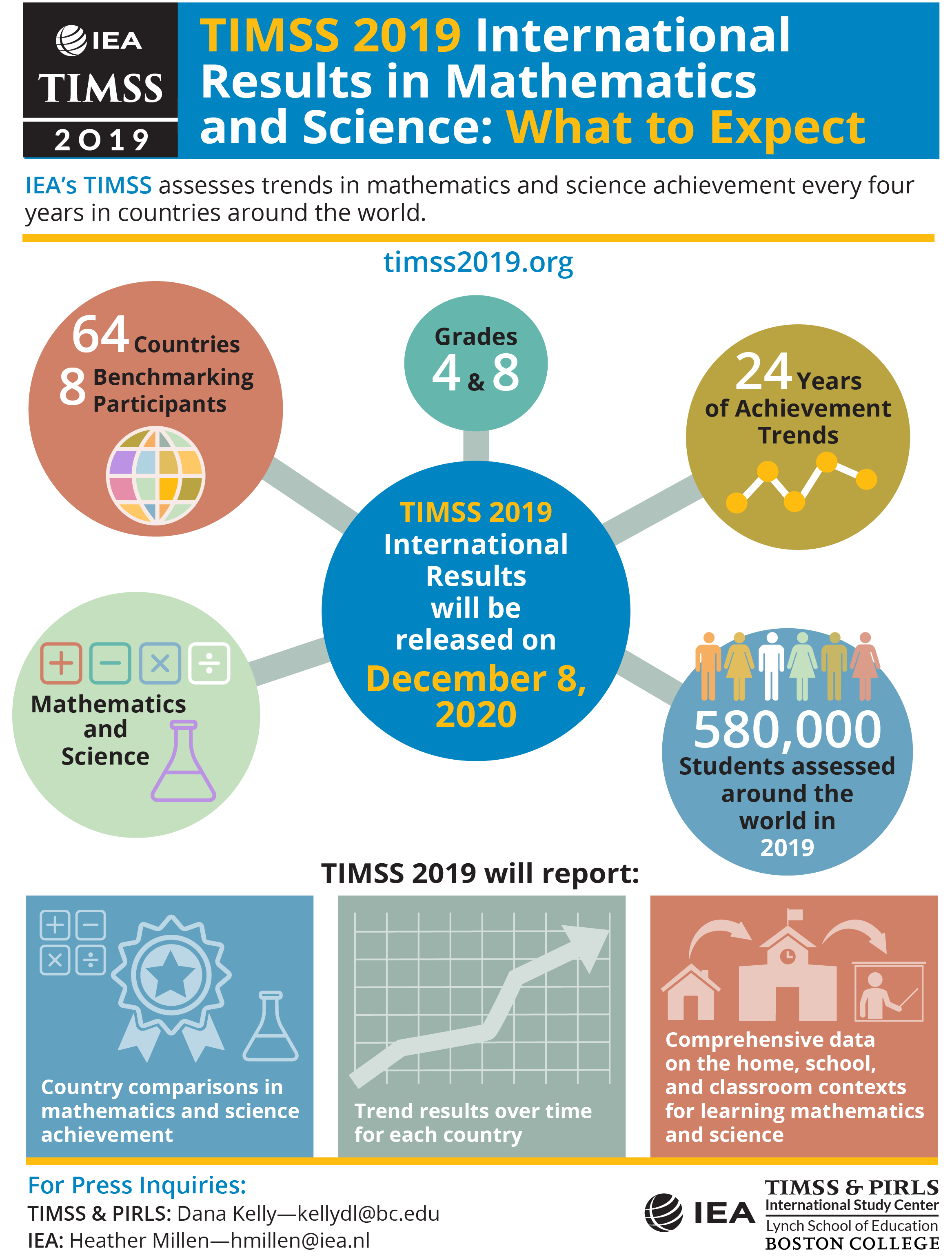Coming December 8: TIMSS 2019 Results
Whether you are new to IEA's TIMSS, or already tuned in, here are some key facts and figures about TIMSS 2019.

TIMSS 2019 Facts and FAQS
Release of TIMSS 2019 International Report
The full international report—TIMSS 2019 International Results in Mathematics and Science—will be released on December 8, 2020, at 10am Central European Time at timss2019.org. In addition to detailed results for the TIMSS countries, the report will include infographics highlighting major findings. Videos that summarize major findings will also be released at the same time, on the TIMSS & PIRLS International Study Center website, and will be available on YouTube.
What is TIMSS?
TIMSS monitors trends in student achievement in mathematics and science and collects extensive information about students’ home, school, and classroom contexts for learning these subjects. TIMSS assesses students at the fourth and eighth grades — targeting the end of the primary and lower secondary (middle) school, while there still is an opportunity to improve student achievement.
TIMSS 2019 is the seventh TIMSS assessment cycle, providing 24 years of trend data since the first assessment in 1995. By reaching its 24-year milestone, TIMSS earns the distinction of establishing the longest trend line of any international education assessment. TIMSS 2019 marked the beginning of the transition to digital assessment, which will be completed with TIMSS 2023.
How many countries and students participated in TIMSS 2019?
TIMSS 2019 assessed 64 countries and 8 benchmarking systems (e.g., regional entities such as provinces and municipalities) and more than 580,000 students.
What will TIMSS report?
- Country comparisons in mathematics and science achievement
- Trend results over time for each country
- Comprehensive data collected on the contexts for learning mathematics and science
How do governments, education ministries, and researchers use TIMSS data?
- Measure the effectiveness of education systems in a global context
- Identify gaps in resources and possible avenues for improvement
- Pinpoint potential weaknesses in curricula and stimulate curriculum reform
- Measure the impact of new education initiatives
- Train researchers and teachers in assessment and evaluation
What does TIMSS assess?
TIMSS works closely with colleagues in the participating countries to assess the mathematics and science that students are expected to know and be able to do according to curriculum guidelines and instructional emphases. TIMSS collects data from countries about their official curricula, and from teachers about whether students have been taught the TIMSS topics. TIMSS has a balanced approach to assessing knowledge, applying, and reasoning skills (two-thirds of the TIMSS assessment questions assess application and reasoning).
IEA’s TIMSS & PIRLS International Study Center at Boston College
TIMSS is the flagship study of IEA (the International Association for the Evaluation of Educational Achievement) and is directed by the TIMSS & PIRLS International Study Center at Boston College. The TIMSS & PIRLS International Study Center is led by Executive Directors Dr. Ina V.S. Mullis, Dr. Michael O. Martin, and Dr. Matthias von Davier.
IEA - International Association for the Evaluation of Educational Achievement
IEA is an independent, international cooperative of national research institutions, governmental research agencies, scholars, and analysts working to research, understand, and improve education worldwide. It conducts high-quality, large-scale comparative studies of educational achievement and other educational aspects, across the globe in order to provide educators, policymakers, and parents with insights into how students perform.
For Press Inquiries
TIMSS & PIRLS International Study Center at Boston College
Dana Kelly, Director, TIMSS and PIRLS Development and Reporting kellydl@bc.edu
IEA (International Association for the Evaluation of Educational Achievement)
Heather Millen, Media Outreach Manager
hmillen@iea.nl
+31 (0) 6 12 32 51 82